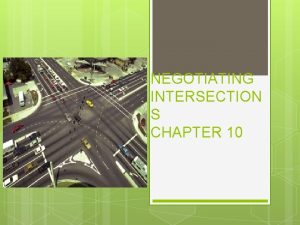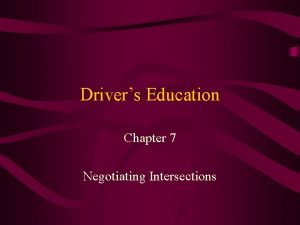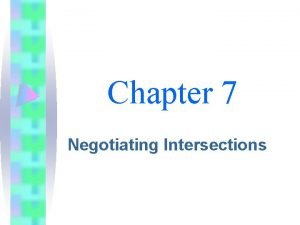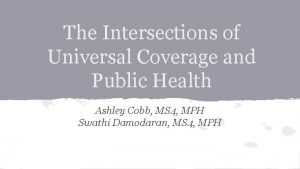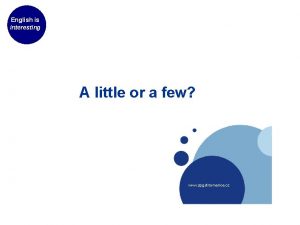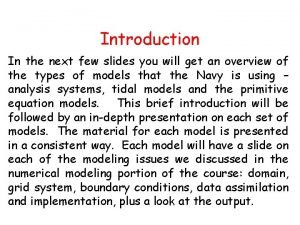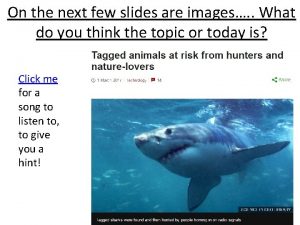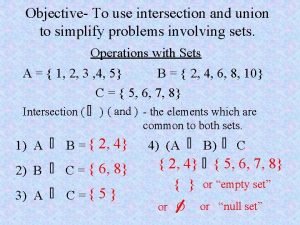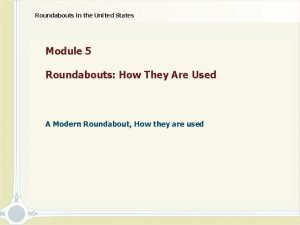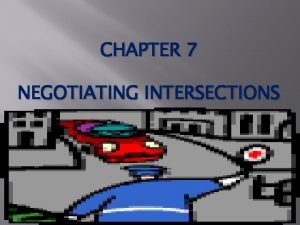Chapter 10 NEGOTIATING INTERSECTIONS On the next few














- Slides: 14

Chapter 10 NEGOTIATING INTERSECTIONS

On the next few slides we will review the 3 types of intersections.

Controlled Intersections 4 -way intersection. What are the rules? Line vehicle up so the front is even with the stop sign. Stop behind any crosswalk or white line. 1 st vehicle to arrive gets to go first If two arrive at the same time – vehicle on the right has the right of way. What if 3 or 4 arrive at the same time…. Who goes first?

Uncontrolled Intersections • • • Yield to the vehicle on the right The vehicle on the left SHOULD (not will) yield to you if you are on the right It doesn’t matter who gets there first Important things to know about the car on your right 1. How fast are they going? 2. Are they turning or going straight? 3. Do they have their turn signal on? Do vehicles ever turn without signaling? Do vehicles ever signal and not turn?

Partially Controlled Intersections • As you approach this type of intersection, ask yourself – do I have a something or nothing? This means – do I have a sign or don’t I have a sign? 1. A nothing has the right of way over a something. Both to the left and right. 2. You will get cut off because you have a something and the other car will take the right of way. Be ready for that!

Approaching An Intersection Determine what kind it is Look 12 -15 seconds ahead – check traffic signs and signals – plan your course. Look 4 -6 seconds ahead – use orderly visual search pattern – what is going on to the left and right of you? Look left, center, and right. Identify potential hazards that include vehicles and pedestrians. 2 seconds POINT OF NO RETURN – at a light it means whatever the light does, you will continue through the intersection. This is based on speed of the vehicle and location on the road.

Approaching an Intersection Deciding to stop – when the light turns yellow – ask “Can I make a safe stop? YES of NO? When you stop behind a vehicle, you should be able to see the tires and the pavement on the vehicle ahead of you. Leave yourself an out – How do I get out of a difficult situation? Entering the intersection – check your line of sight. If there are multiple vehicles to deal with, make sure your path of travel is clear before you proceed.

Right Of Way – Who Gets To Go First! Yield the Right of Way – letting someone else go first even though you have the right of way. Example – someone running a stop sign or the aggressive driver that you don’t know if they will stop. Pedestrians ALWAYS have the right of way – even if they are wrong – they are right!!! See page 189 and 190 in your book for yielding the right of way situations

Gap Selection for Joining Traffic. Time Needed Joining Traffic – turning right or left into lanes of other traffic to make a smooth transition. See the chart on page 191 for how much time and space you need to go left, right, or straight. This shows time for various speeds as well. The 30 mph one would be what is used on our 3 -lane in Milbank. The 45 mph would apply out by Runnings.

Controlled Intersections Fresh Green Light – light just turned green. Stale Green Light – light has been green a while. Predict it will soon change. Yellow Light – prepare to stop – don’t speed through the intersection. Unprotected Left Turn – will be a normal green light – you can proceed, but must yield to oncoming traffic. Protected Left Turn – will be a green arrow – you may proceed – oncoming traffic has a red light. Delayed Green Light – the light in your lane will be different than the lane next to you.

Right on Red Make sure it is legal! How can you tell? If there is no sign that says you can’t, then you can. 1. Come to a complete stop – not a rolling stop. 2. Yield to ALL traffic – the vehicles on your left will have a green light and the right of way. Yield to those vehicles. Also all pedestrians have the right of way as well. 3. When clear – you may make your right turn.

Railroad Crossings Will have a crossbuck and a sign to tell you how many tracks there are. 1. Active crossings – which will have gates, signs, lights, and sounds. You must come to a complete stop! 2. It is not legal to drive around a RR gate! 3. Passive crossings – they will have signs only – see these in the country or roads in town that are not heavily driven. 4. Trains have the right of way!

Roundabouts These have cut down on the number of crashes at intersections because everyone will go to the right and yield to vehicles on the left.

Chapter 10 Review Page 201 – vocab Page 202 – Discussion questions Page 203 - multiple choice
 Chapter 10 negotiating intersections
Chapter 10 negotiating intersections Controlled railroad crossings usually have
Controlled railroad crossings usually have At an open or uncontrolled intersection, yield if _____.
At an open or uncontrolled intersection, yield if _____. An uncontrolled railroad crossing usually has
An uncontrolled railroad crossing usually has Chapter 7 negotiating intersections
Chapter 7 negotiating intersections She's lucky she has few problems
She's lucky she has few problems X.next = x.next.next
X.next = x.next.next A few ja few ero
A few ja few ero Few a few little a little exercise
Few a few little a little exercise Use few or little to complete the sentences
Use few or little to complete the sentences In the next few slides
In the next few slides In the next few slides
In the next few slides Module 5 topic 1
Module 5 topic 1 Intersection vs union
Intersection vs union Module 5 intersections and roundabouts
Module 5 intersections and roundabouts
